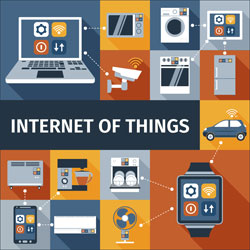According to a new white paper released by iYogi, customer service as we know is about to change forever.
 The white paper, entitled: “How the Internet of Things is Revolutionizing Customer Service” predicts that as the Internet of Things (IoT) becomes a reality, customer problems are going to be fixed proactively – going further than real time to future time, providing insights into possible problems.
The white paper, entitled: “How the Internet of Things is Revolutionizing Customer Service” predicts that as the Internet of Things (IoT) becomes a reality, customer problems are going to be fixed proactively – going further than real time to future time, providing insights into possible problems.
The phrase Internet of Things (frequently abbreviated as IoT) is used to denote connectivity of devices, systems and services that goes further than machine-to-machine communications (M2M) and covers a range of protocols, domains and applications.
Gartner predicts there will be almost 26 billion devices on the Internet of Things by 2020 and based on ABI Research, more than 30 billion devices will be wirelessly connected to the Internet of Things (Internet of Everything) by 2020.
Cisco created a dynamic “connections counter” to track the estimated number of connected things from July 2013 until July 2020. One of the most active research area in IoT is the connection of devices to the internet via low-power radio. The low-power radios do not require Wi-Fi or Bluetooth. Lower-power and lower-cost alternate options are now being researched within the category of Chirp Networks. It has been speculated that all IoT devices will use an “IP” address as a unique identifier.
Vishal Dhar, co-founder at iYogi – Digital Service Cloud, speaking at the IoT World Conference commented:
“The customer service industry is about to see an IoT tsunami change in the next five years. Just as consumers will experience a whole host of new applications; brands, service providers and OEMs will realize the full opportunity of IoT enabled customer services and support. One to one customer engagement practice can now become a reality, as a new layer of connectivity, customer intelligence and automation appear in the service conversation evoking a service delivery revolution”.
The white paper cites that in an IoT world, unified platforms are the way ahead for service providers to track, service and coordinate heterogeneous devices across customer and business solutions. A single interoperable platform using a centralized user interface allows integrated support channels, apps, databases as well as user
tools for a superior consumer experience and driving productivity to operational centers.
Synchronized customer intelligence will become a reality as real time IoT customer data together with predictive analytics enables for speedier service resolution. Intelligence on customer status, locality, functionality and choices makes it possible for service issues to be solved proactively – going further than real-time to future-time, providing insights into possible issues.
Costs of service management will likely be pushed downward, looking beyond a reactive type of support and operating on real-time data, service providers can automatize service solutions to realize cost savings and offer a generally better client experience.
Big Data means personalization and improved customer manageability which offers the biggest possibility yet to gather big data. As additional customers and end users’ devices are hooked up – vendors will recognize each customers’ particular profile and behavioral patterns to provide a lot more personalized customer engagements.
The White Paper predicts that IoT devices will more and more interact without having human involvement in the first instance, through automated customer services and intelligent interventions – qualifying issues with optimal resolutions via self-service resources, utilities and one-to-one service requests.
For higher escalation instances, customer care professionals will certainly take care of service requests in which hands-on involvement is required. Automated customer service has a large role to play in the new generation of the service industry, as IoT propels intelligent automation established on real time data aggregation and analysis. This will enable the device itself – and not necessarily the human user – to interact with a support layer for problem resolution. Reactive to
proactive service support.
An improved know-how about the client profile and most likely behavioral patterns is made feasible by an IoT powered service platform. Real-time customer intelligence gives insights to OEMs and service providers to prepare and predict upcoming customer needs and demands to increase customer lifecycles with opportunities to introduce more services and products.
The fast development of device connectivity is encouraging growth in the marketplace for solutions created to power the Internet of Things. World-wide revenues from M2M services is forecast by Infonetics to grow at an 18% CAGR from 2013 to 2018.
Godfrey Chua, directing analyst for M2M and The Internet of Things, Infonetics Research, commented:
“M2M continues to gather momentum as enterprises, in the never-ending pursuit of competitive advantage, seek to find new ways of using connected technologies to improve business agility and lower operational costs.”
The white paper can be downloaded at: http://www.digitalservicecloud.com/white-paper.




